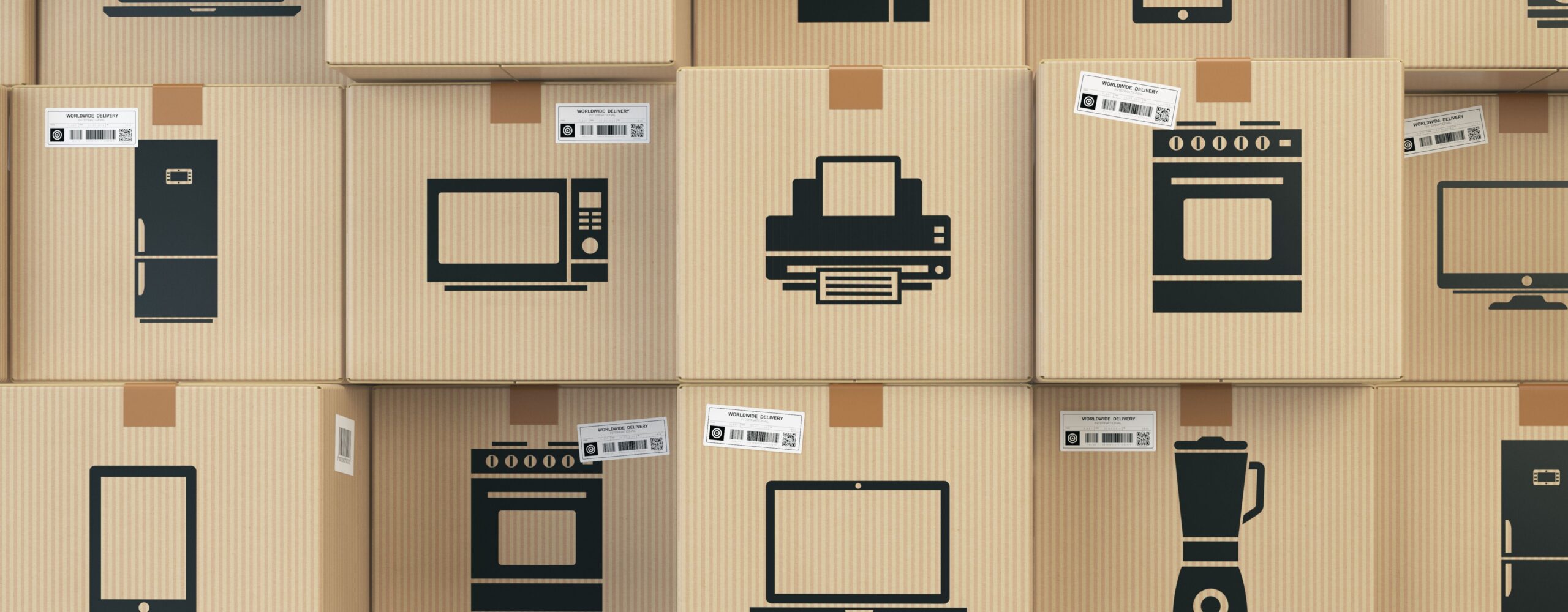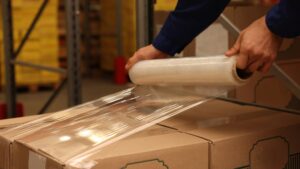The eternal problem of all electronics packers: how to properly secure electronic equipment so that its delivery does not end in a succession of unwanted events: damaged delivery, complaints, returns, customer dissatisfaction?
We have known for a long time that in the world of logistics and e-commerce, it is not only delivery time that matters, but also its security. Electronic equipment is extremely susceptible to various external factors. Even minor shocks or moisture can lead to damage, and electrostatic charges can disrupt the operation of integrated circuits. This is why it is so important to use specialised packaging materials that effectively protect this type of equipment.
This is all the more so because sales of electronics, which are constantly on the rise, and buying equipment online is now a completely normal thing. It is becoming more and more popular to buy electronics or white goods when shopping online. Phones, smartphones, tablets and other electronic devices are on the shopping agenda of 24 per cent of internet users. The average expenditure on household appliances once every six months is PLN 742, and on phones, smartphones, tablets it is PLN 545 (source).
The packaging of electronics aims to protect equipment from mechanical damage, moisture, electrostatic charges and temperature changes. Whether laptops, smartphones, computer components or consumer electronics, the right choice of packaging materials minimises the risk of loss and ensures safe transport. This is all to ensure that the ordered products reach the target customer intact.
In this article, we take a look at how to properly pack electronics to ensure safe shipping and protection during transport.
What risks lurk for electronics in transport and storage?
- Shocks and impacts
Every parcel passes through dozens of hands and sorting systems. A fall from several metres, sudden braking in transit, careless storage – all of these factors can damage electronic equipment, especially if proper cushioning is lacking.
- Moisture and temperature changes
Shipping by sea, long storage in a warehouse or even a simple courier journey in winter can expose electronics to moisture condensation. The result is corrosion, PCB damage and internal short circuits.
- Electrostatic charges (ESD)
One uncontrolled electrostatic pulse can damage sensitive integrated circuits. Lack of ESD protection is one of the most common causes of failure in electronics transport.
- Pressure and overloading
Improperly packaged products can crush under the weight of other parcels, especially in high-bay warehouses and transport vehicles.
Which materials best protect sensitive components?
- Polyethylene foam - cushioning and shock protection
PE foam is excellent at absorbing shocks and protecting delicate components from crushing. It is a lightweight but extremely effective protection. Its thickness can be selected to suit the specifics of the product.
Read also —> Types and uses of polyethylene foam
- Antistatic bubble wrap - ESD protection
ESD bubble wrap neutralises electrostatic charges, which makes it indispensable for transporting electronic components. In addition, the bubble wrap itself protects against impacts and scratches.
Read also —> Types of bubble wrap
- Anti-static bags - essential for components
There is a reason why every processor or RAM is packaged in anti-static bags. Thanks to them, the products are protected from electrostatic damage already during production and transport.
Appropriately designed packaging with foam inserts guarantees protection against pressure and shock, as well as additional stability during transport when equipment may move inside the packaging, increasing the risk of damage. Shapes and inserts with antistatic additives provide excellent protection for electronic products or individual components.
- Moisture barrier packaging - for long term storage
For equipment stored in harsh environments (e.g. shipping), moisture barrier bags and vacuum packaging are used to eliminate the risk of condensation, as well as moisture absorbers – e.g. silica gel sachets protect electronics from moisture.
- Stretch film
Reinforces the packaging, protecting it from opening. It also provides additional protection against moisture and dirt. By using stretch film in a colour such as black, you additionally protect the package against identification of its contents and thus reduce the risk of theft.
Apply tape to the edges and flaps of the box to ensure a secure seal. If you want the tape to be difficult to break (which is not easy if you choose paper tapes) – use glass fibre reinforced tape.
- Warning labels
Lack of ‘Caution’ or ‘Up/Down’ stickers may result in incorrect handling of the parcel by couriers and staff at handling and sorting facilities. Remember, when using courier services, to familiarise yourself with the company’s policy on parcel labelling (this is important in case of damage and complaints).
Become a member of our newsletter audience
Benefits of correct packaging of electronics
- Reducing the number of returns and complaints
Well-protected equipment reaches the customer intact.
- Protection of valuable equipment
Elimination of financial losses associated with damage.
- Positive customer experience
Professionally packaged products build trust in the brand.
- Compliance with transport standards
Meeting shipment security standards avoids logistical problems.
How can you implement these solutions at home?
Now that we know what materials can be used to package electronics, the question remains ‘how?’, i.e. how to put this information into practice. Here are some helpful tips to optimise your packaging process. Implementing them can help you tailor your packaging materials to suit your products, which ultimately results in increased customer satisfaction with their purchase, and will also help build stronger loyalty to your brand.
Match the material to the product
Each type of electronics requires a different form of protection. Delicate components such as processors or SSDs are more susceptible to shocks and electrostatic discharges than, for example, laptops or monitors. How do we translate this into practice?
- Risk analysis - identify the hazards that may arise during transport (shocks, falls, moisture, ESD) and select appropriate protective materials.
- Customised packaging - if you sell different models of equipment, use dedicated PE foam inserts or cardboard dividers to immobilise the product in the box and prevent it from moving.
- Layered protection - for small components, it is worth using multi-layer packaging.
Protect against ESD (electrostatic discharge)
Electronics are particularly vulnerable to electrostatic discharge, which can lead to component damage. To prevent this:
- Use anti-static packaging - choose ESD bags and bubble wrap with anti-static properties, rather than regular foil, which can build up static charges.
- Take care of the packing area - if you are packing a large amount of electronics, equip your workstation with earthing mats and bands to eliminate the risk of products becoming electrified.
Protect against moisture
Moisture can corrode components and damage integrated circuits. To avoid this:
- Use barrier bags and moisture absorbers - for long-term storage or shipping in harsh climatic conditions (e.g. shipping by sea).
- Choose waterproof packaging materials - e.g. coated cardboard, laminated cardboard, PE foam, bubble wrap and strong adhesive packaging tape to protect the parcel from moisture. It will also be helpful to ostretch the carton - this will provide an additional protective barrier.
- Control storage conditions - if you are storing electronics in a warehouse for an extended period of time, check humidity levels and use dehumidifiers if necessary.
Test solutions and monitor effectiveness
There is no one-size-fits-all solution for every situation. The key is to test different packaging methods to find the most effective ones.
- Carry out endurance tests - check how your packaging copes in real-life transport conditions, e.g. through drop tests, vibration tests or moisture resistance tests.
- Monitor returns and complaints - if customers report product damage, analyse the packaging materials used and make improvements.
- Consult the experts - if you are packaging electronics on a large scale, it is worth tapping into the expertise of packaging experts to see if there are more modern and effective methods of securing products.
Checklist for companies - how to check if your packaging is safe?
- Do you use anti-static packaging for sensitive components?
- Are the products protected against moisture?
- Are you using the right cushioning materials?
- Is the packaging sized to fit the products?
- Is the packaging appropriately labelled?
- Do you regularly carry out stress tests on your packaging?
- Do you train your staff in proper packaging?
- Do customers make complaints resulting from damage to the product in transit?
Summary
Packaging electronics is a process that requires appropriate knowledge and the use of specialised materials. Proper protection of devices against mechanical damage, moisture and electrostatic charges guarantees their safe transport. It is therefore no surprise that many companies place great importance precisely on packaging materials.
By choosing PE foam, bubble wrap, ESD packaging and moisture absorbers, equipment can be effectively protected, minimising the risk of loss. Well-packed electronics mean fewer complaints, greater safety and a better customer experience.
Want to know the best packaging for electronics?
Contact Mac-Graf and find the perfect solution for your business!
We can help you and optimize the packaging process in your company
Make an appointment with our advisor

Specializing in the sales of PE foam and bubble wrap, he effectively addresses the needs of clients in the packaging industry. With years of experience, deep market knowledge, and strong negotiation skills, he creates tailored offers and builds long-term business relationships. Outside of work, he’s passionate about basketball — a sport that has taught him the value of teamwork and consistency in achieving goals.









